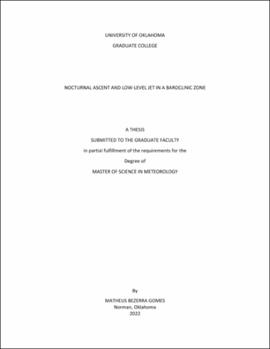| dc.description.abstract | A remarkable feature of the regional climatology of the central United States and the Great Plains is the existence of a nocturnal maximum in convective rainfall during the warm season. This study follows up the work of Shapiro et al. (2018; hereafter S18), in which a linear theory predicts weak but persistent ascent in the nocturnal boundary layer in baroclinic environments such as the United States Great Plains. In the S18 theory, the sudden decay of dry-convective mixing in the convective boundary layer at sunset triggers inertia-gravity waves as well as a Blackadar (1957)-like nocturnal low-level jet. For conditions typical of broad warm-season surface-based baroclinic zones extending over one or more Great Plains states, the theory predicts that air parcels in the ascent phase of the wave can rise 500 m - 1 km in 6 hours. Such large displacements may promote convective initiation and play a role in that region's well-known nocturnal maximum in convective rainfall. In the present study, the CM1 numerical model (Cloud Model 1, developed at NCAR by George Bryan) is used to examine whether the main predictions from the S18 ascent/jet theory arise in a more realistic setting. Specifically, in these simulations, the non-linear terms in the governing equations are retained, and the sudden and total shutdown of turbulence at sunset is replaced by a more realistic evening transition. The first sets of experiments focus on generating nocturnal low-level jets in a barotropic environment [no horizontal temperature gradient; free-atmosphere geostrophic wind is constant and southerly at 10 m s-1] and testing the sensitivity of those jets to a few different parameters. The resulting jets are Blackadar-like, tend to be stronger when the boundary layer is shallower and decrease in strength as the latitude increases ranging from 30oN to 45oN. After confirming that Blackadar-like nocturnal low-level jets can be generated by CM1 when run in a barotropic mode, experiments focused on the impact of baroclinicity. A baroclinic zone arises gradually in the CM1-simulated boundary layer over the course of a 4-day integration period mostly through a temporally constant prescribed deficit in the moisture flux at the surface (a Gaussian function of x, with user-specified amplitude and length scale) which causes greater daytime heating in the center of the domain than in the region outside the baroclinic zone. Aspects of the inertia-gravity wave response predicted in S18 are present in all the simulations. In particular, the main zone of ascent that develops after the evening transition is found to slowly descend with time. The peak vertical velocity and duration of the ascent are qualitatively similar to what is predicted by the S18 theory, however the onset of the ascent is generally earlier than predicted in S18. Unlike S18, the peak vertical velocity increases as the free-atmosphere geostrophic wind gets weaker. This discrepancy may likely reflect the fact that S18 does not retain non-linear terms in the governing equations. | en_US |
